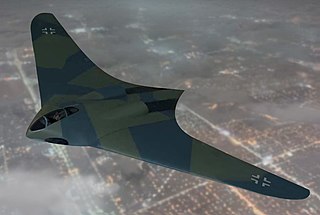
The Horten H.IX, RLM designation Ho 229 was a German prototype fighter/bomber designed by Reimar and Walter Horten to be built by Gothaer Waggonfabrik. Developed at a late stage of the Second World War, it was one of the first flying wing aircraft to be powered by jet engines.

The Junkers Jumo 004 was the world's first production turbojet engine in operational use, and the first successful axial compressor turbojet engine. Some 8,000 units were manufactured by Junkers in Germany late in World War II, powering the Messerschmitt Me 262 fighter and the Arado Ar 234 reconnaissance/bomber, along with prototypes, including the Horten Ho 229. Variants and copies of the engine were produced in Eastern Europe and the USSR for several years following the end of WWII.

The BMW 003 is an early axial turbojet engine produced by BMW AG in Germany during World War II. The 003 and the Junkers Jumo 004 were the only German turbojet engines to reach production during World War II.

The Heinkel He 280 was an early turbojet-powered fighter aircraft designed and produced by the German aircraft manufacturer Heinkel. It was the first jet fighter to fly in the world.

The Ishikawajima Ne-20 was Japan's first turbojet engine. It was developed during World War II in parallel with the nation's first military jet, the Nakajima Kikka.
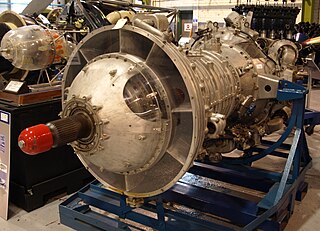
The Rolls-Royce RB.39 Clyde was Rolls-Royce's first purpose-designed turboprop engine and the first turboprop engine to pass its civil and military type-tests.
This article outlines the important developments in the history of the development of the air-breathing (duct) jet engine. Although the most common type, the gas turbine powered jet engine, was certainly a 20th-century invention, many of the needed advances in theory and technology leading to this invention were made well before this time.

The Heinkel HeS 011 or Heinkel-Hirth 109-011(HeS - Heinkel Strahltriebwerke) was an advanced World War II jet engine built by Heinkel-Hirth. It featured a unique compressor arrangement, starting with a low-compression impeller in the intake, followed by a "diagonal" stage similar to a centrifugal compressor, and then a three-stage axial compressor. Many of the German jet-powered aircraft designs at the end of the war were designed to use the HeS 011, but the HeS 011 engine was not ready for production before the war ended in Europe and only small numbers of prototypes were produced.

The Klimov VK-1 was the first Soviet jet engine to see significant production. It was developed by Vladimir Yakovlevich Klimov and first produced by the GAZ 116 works. Derived from the Rolls-Royce Nene, the engine was also built under licence in China as the Wopen WP-5.
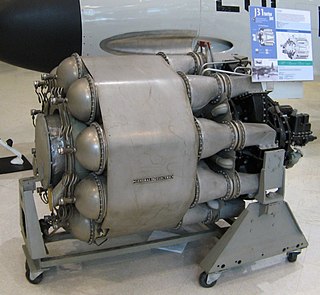
The General Electric J31 was the first jet engine to be mass-produced in the United States.
The HeS 30(HeS - Heinkel Strahltriebwerke) was an early jet engine, originally designed by Adolf Müller at Junkers, but eventually built and tested at Heinkel. It was possibly the best of the "Class I" engines, a class that included the more famous BMW 003 and Junkers Jumo 004. As it started somewhat later than these two designs, and was thus expected to enter service later, the Reichluftfahrtministerium (RLM) ordered Heinkel to stop work on the design and put their efforts into more advanced designs.

The Heinkel HeS 3 was the world's first operational jet engine to power an aircraft. Designed by Hans von Ohain while working at Heinkel, the engine first flew as the primary power of the Heinkel He 178, piloted by Erich Warsitz on 27 August 1939. Although successful, the engine had too little thrust to be really useful, and work started on the more powerful Heinkel HeS 8 as their first production design.
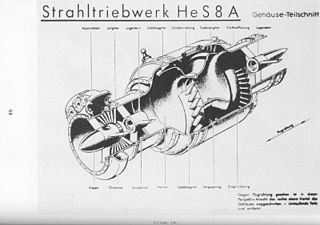
The Heinkel HeS 8 was an early jet engine designed by Hans von Ohain while working at Heinkel. It was the first jet engine to be financially supported by the RLM, bearing the official name 109-001. Had development continued it would have been known as the Heinkel 001, but it does not appear this was used in practice.
The Avro Canada TR.4 Chinook was Canada's first turbojet engine, designed by Turbo Research and manufactured by A.V. Roe Canada Ltd. Named for the warm Chinook wind that blows in the Rocky Mountains, only three Chinooks were built and none were used operationally. After being scaled up from 2,600 lbf (12 kN) to 6,500 lbf (29 kN), it would become the Orenda.
The Lyulka TR-1 was a turbojet designed by Arkhip Lyulka and produced by his Lyulka design bureau. It was the first indigenous Soviet jet engine.
The Packard XJ41 was a turbojet aircraft engine developed by the Packard company in the mid-1940s.
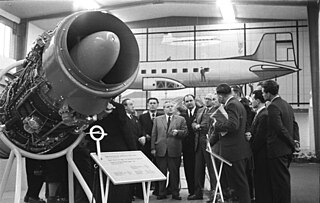
The Pirna 014 was an axial turbojet designed in East Germany in the mid- to late 1950s by former Junkers engineers, who were repatriated to East Germany in 1954 after being held in custody in the Soviet Union following World War II.
The Daimler-Benz DB 007 was an early German jet engine design stemming from design work carried out by Karl Leist from 1939. This was a complex design featuring contra-rotating stages and a bypass fan, making it one of the earliest turbofan designs to be produced. The end result of the design work was built as the DB 007 and began testing on a test-bed on 27 May 1943. Due to the expected low performance, complexity and the good results achieved by much simpler designs, work was halted on the DB 007 in May 1944 by order of the RLM.
The BMW 018 was an early axial-flow turbojet engine project by BMW AG in Germany.